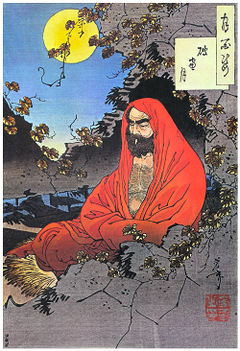Bodhidharma: Difference between revisions
(Created page with "[6th century A.D.] An Indian Buddhist missionary to China who founded the Ch’an, or Zen, sect of Buddhism in an effort to return the religion to the true spirit of Gau...") |
No edit summary |
||
| Line 1: | Line 1: | ||
[6th century A.D.] An Indian Buddhist missionary to China who founded the Ch’an, or [[Zen]], sect of Buddhism in an effort to return the religion to the true spirit of [[ | [[File:BodhidharmaYoshitoshi1887.jpg|thumb|upright=0.8|alt=caption|Bodhidharma, by Yoshitoshi (1887)]] | ||
[6th century <small>A.D.</small>] An Indian Buddhist missionary to China who founded the Ch’an, or [[Zen]], sect of Buddhism in an effort to return the religion to the true spirit of [[Gautama]]’s teachings. | |||
Bodhidharma taught that the Buddha was not to be found in books or images but in the heart of man and that the way to achieve enlightenment was through meditation. He spent nine years in intense meditation in a cave in northern China and was described as having a fierce disposition, penetrating eyes, and an abrupt and direct manner. According to Buddhist lore, in a fit of anger at having fallen asleep during meditation Bodhidharma cut off his eyelids. His intensity of purpose was characteristic of Ch’an devotees, who would undergo any austerity in order to attain the highest enlightenment. | Bodhidharma taught that the Buddha was not to be found in books or images but in the heart of man and that the way to achieve enlightenment was through meditation. He spent nine years in intense meditation in a cave in northern China and was described as having a fierce disposition, penetrating eyes, and an abrupt and direct manner. According to Buddhist lore, in a fit of anger at having fallen asleep during meditation Bodhidharma cut off his eyelids. His intensity of purpose was characteristic of Ch’an devotees, who would undergo any austerity in order to attain the highest enlightenment. | ||
In a dictation given October 8, 1994, El Morya revealed that Bodhidharma was one of the incarnations of Lanello. He said: | In a dictation given October 8, 1994, El Morya revealed that Bodhidharma was one of the incarnations of [[Lanello]]. He said: | ||
: Lanello comes to you often with the terse comment or merely a look of his eyes.... I announce this so that you will understand what sort of Masters we are—Zen, terse, concise, humble, truly not making much of the ego of the self but embracing the cosmos and the great T’ai Chi.<ref>{{ | : Lanello comes to you often with the terse comment or merely a look of his eyes.... I announce this so that you will understand what sort of Masters we are—Zen, terse, concise, humble, truly not making much of the ego of the self but embracing the cosmos and the great T’ai Chi.<ref>{{POWref|37|40}}</ref> | ||
== Sources == | == Sources == | ||
| Line 12: | Line 14: | ||
<references /> | <references /> | ||
[[Category:Embodiments of Lanello]] | |||
Revision as of 02:51, 9 June 2016

[6th century A.D.] An Indian Buddhist missionary to China who founded the Ch’an, or Zen, sect of Buddhism in an effort to return the religion to the true spirit of Gautama’s teachings.
Bodhidharma taught that the Buddha was not to be found in books or images but in the heart of man and that the way to achieve enlightenment was through meditation. He spent nine years in intense meditation in a cave in northern China and was described as having a fierce disposition, penetrating eyes, and an abrupt and direct manner. According to Buddhist lore, in a fit of anger at having fallen asleep during meditation Bodhidharma cut off his eyelids. His intensity of purpose was characteristic of Ch’an devotees, who would undergo any austerity in order to attain the highest enlightenment.
In a dictation given October 8, 1994, El Morya revealed that Bodhidharma was one of the incarnations of Lanello. He said:
- Lanello comes to you often with the terse comment or merely a look of his eyes.... I announce this so that you will understand what sort of Masters we are—Zen, terse, concise, humble, truly not making much of the ego of the self but embracing the cosmos and the great T’ai Chi.[1]
Sources
Pearls of Wisdom, vol. 31, no. 77.
- ↑ Pearls of Wisdom, vol. 37, no. 40.
